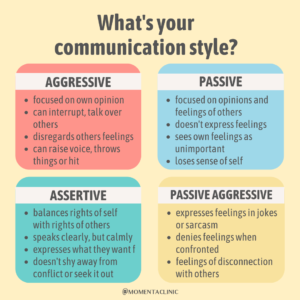Blog







Communication is the cornerstone of our daily interactions, shaping how we relate to others and express our thoughts and feelings. Communication is a broad umbrella that includes both non-verbal and verbal communication. Verbal communication encompasses the use of spoken or written words to convey messages, thoughts, and emotions. This can pertain to your choice of words and expressions. This form of communication is instrumental in articulating ideas, sharing information, and engaging in meaningful conversations. On the other hand, non-verbal communication involves the exchange of messages through gestures, facial expressions, body language, and other non-linguistic cues. Non-verbal communication plays a pivotal role in conveying emotions, intentions, and attitudes, often complementing and enriching verbal interactions.
By becoming aware of your communication style, you can navigate conversations with transparency, clarity and empathy. By taking this approach to communication, it can help you to foster meaningful connections. At the Momenta Clinic, we believe in the power of diverse perspectives and respectful communication in building strong relationships.
Let’s explore four common communication styles: assertive, aggressive, passive, and passive-aggressive.
Assertive communication involves expressing your thoughts, needs, and boundaries in a direct and respectful manner. It is characterized by clear and honest communication while balancing your own feelings while also considering the feelings of others. Assertive communicators advocate for themselves while actively listening to different viewpoints, nurturing open dialogue and mutual understanding. This type of communication can involve flexibility, where you are able to understand your own perspective, but also be flexible to understand and empathize where others might be coming from. Those who tend to communicate assertively can build strong, genuine relationships where they feel supported and enjoy providing support to others.
On the other hand, aggressive communication is marked by a forceful and confrontational approach. Aggressive communicators prioritize their needs over others’, often using intimidation or hostility to assert dominance. This style can lead to conflicts and strained relationships, as it lacks empathy and collaboration. It can create a false sense of connection, where others may appear to agree or comply with an aggressive person to avoid conflict or tension. This can create unbalanced relationships and ultimately dissatisfaction even for the person who is communicating aggressively.
Passive communication involves avoiding conflict and prioritizing others’ needs at the expense of one’s own. Individuals using passive communication may struggle to express their thoughts and feelings, leading to misunderstandings and unmet expectations. This style often results in suppressed emotions and unassertive behavior, hindering genuine connections. Sometimes anxiety about offending others, hurting others feelings or the fear of being judged can prevent one from expressing themselves. It can lead to dissatisfying relationships and a feeling of being perpetually misunderstood.
A blend of passive and aggressive traits, passive-aggressive communication often involves indirect expressions of anger or resentment. Individuals using this style may appear compliant on the surface, but harbor underlying hostility or resistance. Passive-aggressive communication can erode trust and create tension in relationships, as it obscures honest and transparent dialogue. It can take the form of pointed jokes or sarcasm. This can give an appearance of humour, but can be hurtful and can create distance as it does not allow for true feelings to come to the surface.
It should be noted that factors of context, including circumstances and culture may influence one’s communication and despite the benefits of assertive communication, it may not always be the right choice in every situation. As we learn about building health relationships, setting boundaries, limits and letting some relationships go while nurturing others may be part of your process.
By recognizing and reflecting on your communication style, you can enhance your self-awareness and interpersonal skills. At the Momenta Clinic, our team of therapists from diverse backgrounds employs research-backed methods to support you in developing effective communication strategies. Together, we can cultivate a communication style rooted in integrity, compassion, and mutual respect, fostering authentic connections and meaningful dialogue. Whether you choose to meet our therapists online or in-person at our Brampton or Toronto locations, our talented therapists are excited to help you on your journey to create healthy relationships, gain insight and personal growth.
Embrace self-awareness, cultivate empathy, and nurture authentic connections through your communication style at the Momenta Clinic.